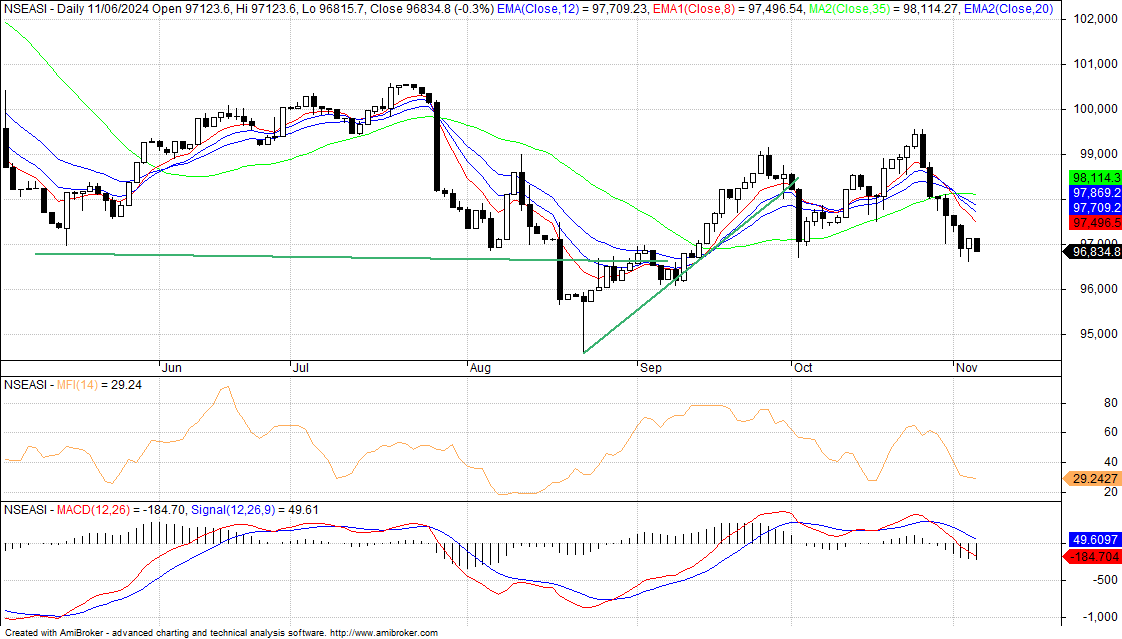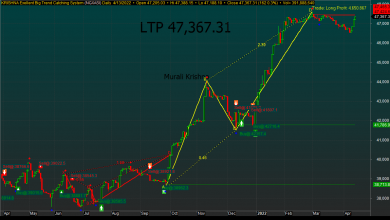Bulls Stay On Sidelines As Nigeria’s Composite Index Extends Losses, Investors Shed ₦367bn Amid Weak Breadth

Market Overview:
The Nigerian equities market maintained its negative momentum on Wednesday, reflecting sustained sell pressure across blue-chip, banking, and consumer goods counters. The NGX All-Share Index (NGXASI) shed 0.42%, closing at 138,157.16 points, from the previous session’s 138,737.64 points. This decline translated into a market capitalization loss of ₦367.29bn, dragging the YTD return to 34.23%.
The persistent downtrend was driven by profit-taking and portfolio rebalancing, particularly in CAP (-7.41%), PZ (-6.77%), NB (-5.71%), OANDO (-3.09%), UBA (-2.03%), ZENITHBANK (-1.15%), GTCO (-1.09%), ACCESSCORP (-0.97%) and other high-cap stocks that collectively weighed on the market. This negative sentiment was reinforced by weak market breadth as 42 decliners outpaced 13 gainers. NSLTECH topped the advancers’ chart, while LEGENDINT, LEARNAFRCA, and DAARCOMM closed at the bottom of the losers’ table.
Market Activity and Investor Sentiment:
Despite the bearish close, activity levels remained relatively strong, suggesting cautious accumulation at lower price levels. Total traded volume rose 18.45% to 482.76m units, while value surged to ₦19.67bn across 28,193 deals. ACCESSCORP remained the most traded stock by volume, contributing 8.91% of total trades, followed by FIDELITYBK (8.31%) and GTCO (7.22%).
By value, ARADEL dominated turnover with ₦6.46bn, representing 32.83% of the day’s transaction value, supported by strong institutional activity. GTCO and UBA followed as investors continued to rebalance portfolios within the banking space ahead of Q3 earnings expectations.
Technical Market View:
Technically, the NGXASI continues to trend in a corrective phase, trading below its 20-day and 50-day moving averages, indicating sustained short-term weakness. The candlestick formation for the session shows a modestly sized bearish candle with slight lower-shadow support, suggesting mild buy-side activity but insufficient to reverse sentiment.
Market breadth remains negative, and the Money Flow Index (MFI) is trending downward, confirming waning accumulation pressure. The Relative Strength Index (RSI) sits around 44, indicating that the market is approaching oversold territory, which could trigger a technical rebound if bargain hunters step in.
Immediate support is pegged around the 137,800-point region, which coincides with the lower Bollinger Band, while a break below could open the way to the next support at 137,200 points. Resistance levels are seen around 139,000 and 140,000 points, where any breakout could attract momentum traders seeking a short-term bounce.
Market sentiment is still cautious, with investors waiting for a clearer catalyst such as corporate earnings upgrades, macroeconomic policy clarity, or fresh liquidity injections from institutional investors before taking aggressive long positions.
Global and Commodities Market Update:
On the global scene, crude oil prices retreated nearly 2% ahead of Sunday’s OPEC+ meeting. Brent crude settled at $68.05 per barrel, while WTI fell to $64.43 per barrel. The focus is on whether the cartel will accelerate the unwinding of additional voluntary output cuts (1.65mbpd) earlier than scheduled, a move that could pressure prices further in the short term. This development remains crucial for Nigeria’s fiscal position, external reserves accretion, and FX market stability.
Outlook for Next Session:
We expect a mixed-to-negative sentiment to persist in the next session as the market searches for a bottom in the face of sustained profit-taking and portfolio rotation. Bargain hunters are likely to re-enter gradually as RSI nears oversold levels, particularly in fundamentally sound dividend-paying stocks that have pulled back to attractive entry points.
We advise investors to remain tactical, focusing on value stocks with strong earnings prospects, robust cash flows, and attractive dividend yields. Traders should also watch for reaction around key technical support zones as a potential signal for a short-term rebound.






